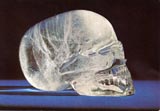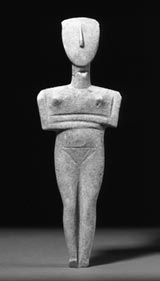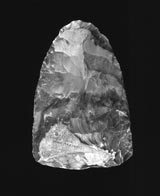| Unidentified Museum Objects -
Curiosities from the British Museum, 2002. Gallery 4, Henry Moore Institute, Leeds, curated by James Putnam and Stephen Feeke. 12 December 2001 - 28 February 2002. Objects in museums are usually defined by their former function and we - the viewers and visitors - are accustomed to being told what something did or how it was used. We look for a label, we believe what it says and then move on. What do we do, however, when the experts are unable to confirm what something is? with no written definition to rely on, colour, texture, shape and material seem more noticeable. Moreover we are free to speculate for ourselves. This exhibition explored the dialectic between a museum's authoritative stance and the possibilities of our own imaginative responses. Museums have a mission to provide a scientific appraisal of their collections in the light of constantly updated research, but there are a number of objects which continue to challenge the specialists. This exhibition celebrated the specimens that have heroically evaded attempts to classify them. Many of these 'Unidentified Museum Objects' continue to inspire what is sometimes wild speculation but ultimately they remain mysterious. Others survive in such large numbers and are so familiar in museums around the world that we may think we know what they are - when in fact we don't. There are also some items that have attracted explanations which, for now at least appear to be logical. Although the exhibition's catalogue entries summarised the current thinking and latest theories about the selected objects, their definitions are fluid and subject to change as research continues. Selected images: 1st image from top: The Crystal Skull, rock crystal, origin and date uncertain, possibly European, 19th century AD? Initially these objects were identified as rare examples of Aztec or Miztec art made in Mexico prior to the Spanish Conquest in the 16th century. As artefacts from lost civilizations, the skulls were thought to have religious significance and even magical powers. Recent scientific research has determined that a European jeweller's wheel was used to incise some of the decoration which suggests it is not ancient Mexican. However, it still remains feasible that the skull was made at an earlier date and then reworked. 2nd image from top: Cycladic Figurine, marble, c2500-2300 BC, from Cyclades, Greece The precise use and significance of these figurines remains a mystery and no generalisations can easily be made. Most are female, but some are male. Most are single figures, but some couples also exist. Most though not all are found in graves. Most are small, but some examples approach life-size. 3rd image from top: Handaxe, flint, Lower Palaeolithic, around 350,000 years old, from Biddenham, Bedfordshire, England The basic design of stone axes persisted for almost 1.5 million years. They appeared first in Africa then spread to S. Asia, the Middle East and then to Europe. Although called 'hand axes' some of them are too large to fit the hand and they frequently show no trace of wear, suggesting they had a purely votive function. To read more about this exhibition visit The British Museum's website. |
 |
||
| The Crystal Skull, rock crystal, origin and date uncertain, possibly European, 19th century AD?. |
|||
 |
|||
| Cycladic Figurine, marble, c2500-2300 BC, from Cyclades, Greece. |
|||
 |
|||
| Handaxe, flint, Lower Palaeolithic, around 350,000 years old, from Biddenham, Bedfordshire, England. |
|||
|
|
|||